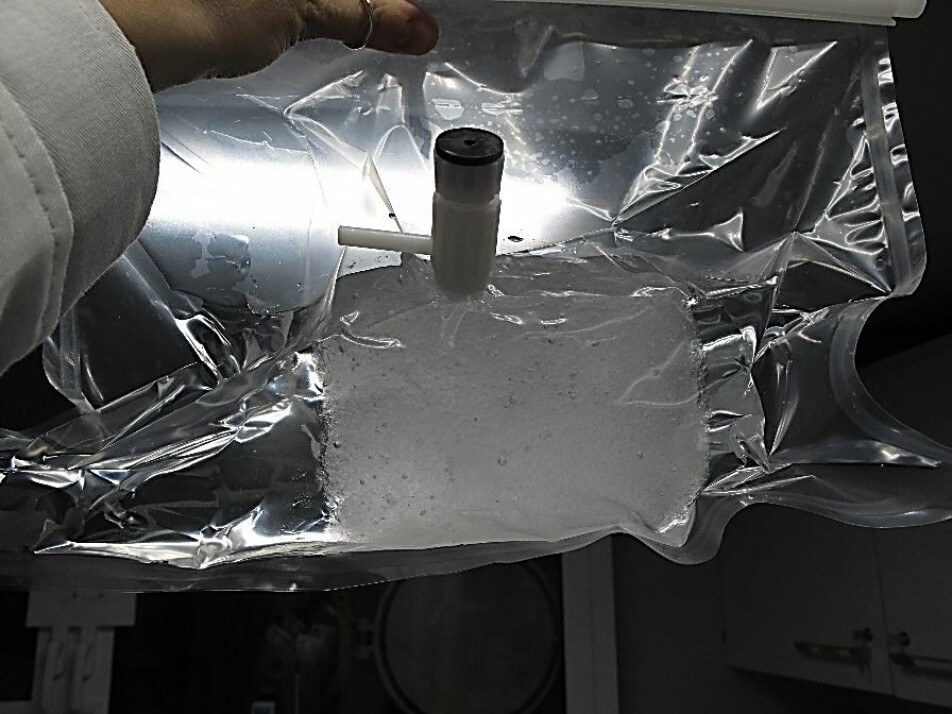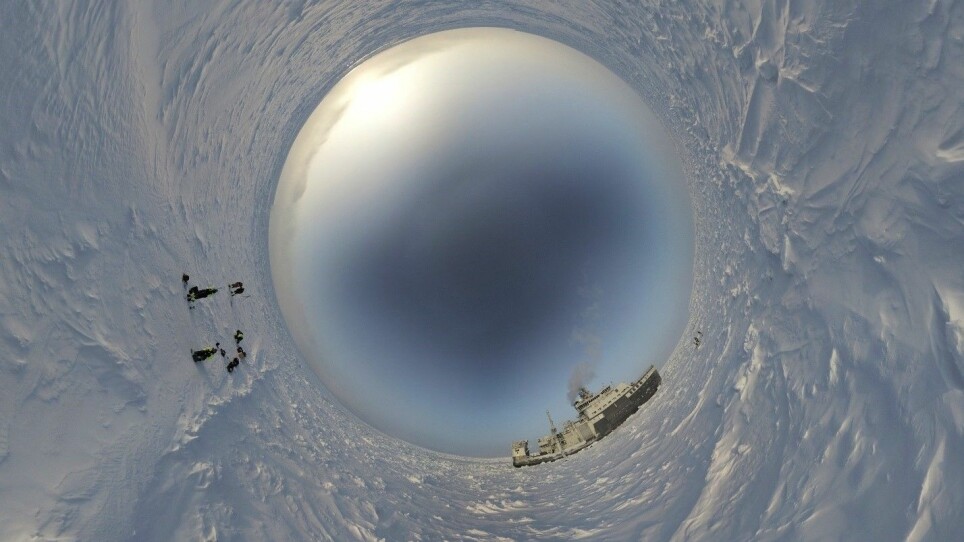
Everything has to have somewhere to live
Here on RV “Kronprins Haakon” in the northern Barents Sea we are our own tiny world, living and working together in a bubble almost completely remote from our regular world. In our microcosm we are reminded that we all have to have some place to live, and to also understand how it works, so that the system we live in functions well.
Looking outward to the icy seas around us, we see a dramatic ‘blue desert’ – a vast treeless plain which both provides a platform for life, and is also shaped by the life around it. Understanding this system-of-systems is the core work of researchers focused on sea ice physical, optical and chemical characteristics; ocean chemistry, optical properties of water, down to the sea floor and its composition.
Starting at the surface, the sea ice physical properties team looks at what the sea ice is made of, how it is structured, and how it changes – more or less the visible parts of a tiny skin of ice between the ocean and the atmosphere. We spend many hours walking around with an electromagnetic induction sounder and a snow depth probe made for geophysical and hydrological applications. With these we seek to understand the distribution of sea ice thickness and snow depth across a single ice floe.

Then, we collect ice cores to understand the detailed structure of sea ice, its density and salinity. These simple datasets are critical to inferences of sea ice thickness and structure from satellite instruments. They help us understand what can be seen from space, and how to interpret the data we get from space-based observations.
We use airborne instruments of our own – a helicopter towing an electromagnetic induction sounder and carrying a pair of cameras. This setup helps us look at larger regions, reconstructing sea ice depth and surface topography over tens to hundreds of kilometers. A small drone fills in gaps at ice floe scales, generating ‘floe scale’ reconstructions of surface topography using many overlapping images.

Putting all this together, we aim to understand how the ice is put together, how snow and sea ice ridges are distributed, how much ice is being made, melting, or drifting from one place to another. In turn, we hope to provide a picture about where things live on the ice – how much ridged area, for example, gives an idea of how much space there is for small animals and fish to hide from larger predators. The snow distribution gives an idea of how much light might be available under the ice; the floe size distribution an idea of how much ice perimeter is available for sea water inwashing to the space between snow and ice where things can live.
In the process, we sometimes catch things in the act of living! Just a small waterproof camera on a stick can tell us about how the physical stuff we study provides room to shelter and live, like this serendipitous capture of juvenile polar cod living in situ. Without taking small chances to engage our curiosity and wonder in seemingly trivial activities, we would otherwise only be able to guess at what is really happening in there.

This polar cod specimen, as well as all the living organisms who live in and around the sea ice and upper ocean, depend in one way or another on light. Tristan Petit works on understanding the evolution of the light climate in the northern Barents Sea with climate change. In order to adjust his mathematical models, he first needs to measure different quantities that affect the propagation and extinction of light from the bottom of atmosphere to a hundred meters depth in the ocean. This begins by measuring the snow/ice albedo, which corresponds to the portion of light reflected by its surface, as well as its transmittance, which quantifies the remaining portion of light at the bottom of the ice.
Then, we measure the vertical structure of the light absorption and scattering within water which gives indication on the ability of water to transmit light and depends on the quantity of three types of water constituents. There are first micro algae, called phytoplankton, whose most common species absorb mainly the blue, and to a lesser extent red, part of the light spectrum. Phytoplankton is the main driver of the ocean colour in most of the open sea waters around the world. Then the Colored Dissolved Organic Matter (CDOM) absorbs blue light and is thus sometimes called “yellow substance” as it transmits well the green and red light. And finally, the Non-Algal Particles (NAP) are the strongest scatterers and are thus sending back part of the light to the atmosphere. CDOM and NAP are mostly present in coastal areas but can also be produced from the phytoplankton degradation.

The ocean itself is both the physical home for an in incredible array of life on Earth, and a vital ‘blanket’ for everything which doesn’t actually live in it.

The sea ice forms a unique environment for the cycling of different chemical compounds and the exchanges of these between the ocean and the atmosphere. Ice cores are collected and sectioned to understand the variability of carbonate chemistry, inorganic nutrients and tracers for different water sources from the top of the ice to the base of the ice pack. In addition, measurements are made in the unique structures that characterise the ice zone, such as in snow, under-ice seawater, brines and frost flowers. These datasets provide a better insight into the role of sea ice in polar ocean chemistry and how that might shift during this period of environmental change.
High in the Arctic, working in temperatures down to 30 degrees below the freezing point of our bodies, we are acutely aware that we are visitors here - permitted to exist in our cocoon of steel as long as we guide it wisely. In a way it is better to think of our place here that way, contained in a tiny bubble and exploring outward to find our limits, or seek new knowledge.

This space both calls to our sense of wonder and serves as a reminder that we are just a part of an intricate and complex system of systems. There is no doubt that it is a privilege to be here, and a key part of all our roles as researchers is to communicate that sense of surreal amazement.
For us as researchers we have to sometimes narrow our focus to understand a very specific component of one aspect of this dynamic system-of-systems. This is where we get into the dry nuts and bolts of science – statistics, graphs, long and complicated words. Approaching our work with curiosity and wonder is essential to seeing how this narrow focus fits into the larger puzzle.
As geographers, physical scientists, chemists, we are concerned with the scaffolding which sets the stage for life to happen – which in turn is shaped by life itself! Everything has to have somewhere to live, and we are lucky to be able to discover how this works in the inhospitable – at least to us humans - high Arctic.







